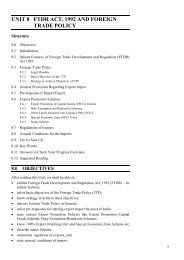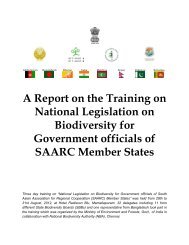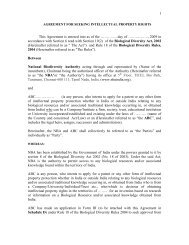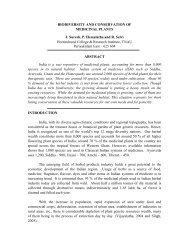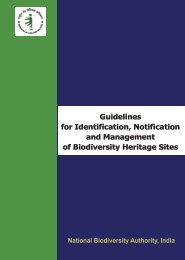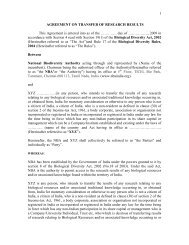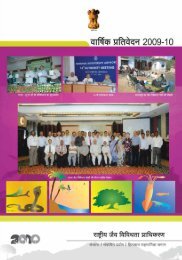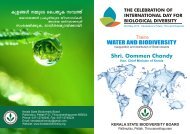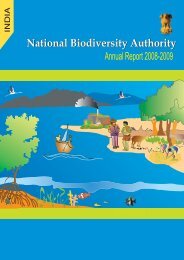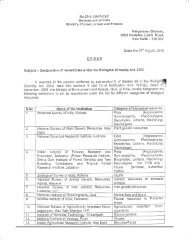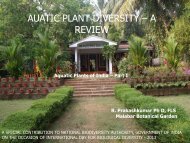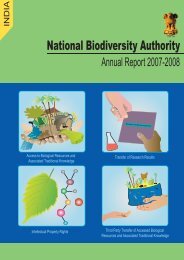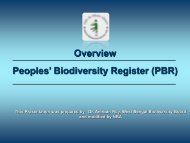BCIL BOOK.pmd - National Biodiversity Authority
BCIL BOOK.pmd - National Biodiversity Authority
BCIL BOOK.pmd - National Biodiversity Authority
Create successful ePaper yourself
Turn your PDF publications into a flip-book with our unique Google optimized e-Paper software.
NATIONAL BIODIVERSITY ACTION PLAN<br />
private participation; (viii) lack of full realization of<br />
people’s participation; (ix) inadequate targeted research<br />
and extension studies; (x) inadequate frontline staff<br />
and that too of older age group; (xi) less emphasis on<br />
forestry research; (xii) lack of on-job training and<br />
capacity building for forest officers especially for the<br />
frontline staff; (xiii) general neglect of full potential<br />
of NTFPs; and (xiv) lack of supportive land use policy.<br />
Remedial actions for restoration of degraded areas<br />
have been undertaken through eco-restoration<br />
programmes by involving local people. Special<br />
attention has been given to coastal zones through<br />
Coastal Zone Regulation Rules, 1991 under the<br />
Environment (Protection) Act. This notification is<br />
under reformulation based on scientific principles as<br />
recommended by Swaminathan Committee (2005),<br />
and a draft notification on Coastal Management Zone<br />
2008 has been issued.<br />
NAEB in the MoEF gives special attention to<br />
regeneration of degraded forests and lands adjoining<br />
forest areas, national parks, sanctuaries and other PAs<br />
as well as ecologically fragile areas such as the<br />
Himalayas, Aravallis and Eastern Ghats. The functions<br />
of NAEB involve evolving mechanisms for ecological<br />
restoration of degraded forests and adjoining lands<br />
through systematic planning and implementation in a<br />
cost effective manner. It also sponsors projects for<br />
extension of research findings to disseminate new and<br />
proper technologies for the above. To complement<br />
the initiatives of JFMCs, a new programme called<br />
<strong>National</strong> Afforestation Programme (NAP) was<br />
launched during 2002-03. Under this programme, an<br />
extent of 14.1 lakh ha is being covered by 28,181<br />
JFMCs under 782 FDAs in 28 states.<br />
Various programmes initiated by the MoEF<br />
including NAP, setting up of JFMCs and Hill Area<br />
Development Programme focus on greater<br />
participation of the communities with the objective<br />
of improving their livelihoods. These programmes also<br />
help in poverty alleviation in the respective areas.<br />
The involvement of private sector is encouraged<br />
in activities for the sustainable use of biodiversity. For<br />
example, both public and private sectors – comprising<br />
individuals, companies, cooperatives, and industry -<br />
are playing key roles in the management of forests.<br />
The private sector has also demonstrated its ability to<br />
enhance the productivity of wastelands and is<br />
dominant in the areas of wood harvesting and<br />
processing.<br />
‘Honey Bee Network’ is an important example to<br />
illustrate the measures taken to protect and encourage<br />
customary use of biological resources in India.<br />
Current efforts at promoting conservation and<br />
sustainable use notwithstanding, there is a need to<br />
further augment the natural resource base and<br />
integrate sustainable use concept in all relevant<br />
economic sectors (such as agriculture, animal<br />
husbandry, fisheries, forestry and industry) so as to<br />
ensure intra- and inter-generational equity .<br />
Action Points<br />
Secure integration of biodiversity concerns into<br />
inter-sectoral policies and programmes to identify<br />
elements having adverse impact on biodiversity<br />
and design policy guidelines to address such issues.<br />
Make valuation of biodiversity an integral part of<br />
pre-appraisal of projects and programmes to<br />
minimize adverse impacts on biodiversity.<br />
Promote decentralized management of biological<br />
resources with emphasis on community<br />
participation.<br />
Promote sustainable use of biodiversity in sectors<br />
such as agriculture, animal husbandry, dairy<br />
development, fisheries, apiculture, sericulture,<br />
forestry and industry.<br />
Promote conservation, management and<br />
sustainable utilization of bamboos and canes, and<br />
36



